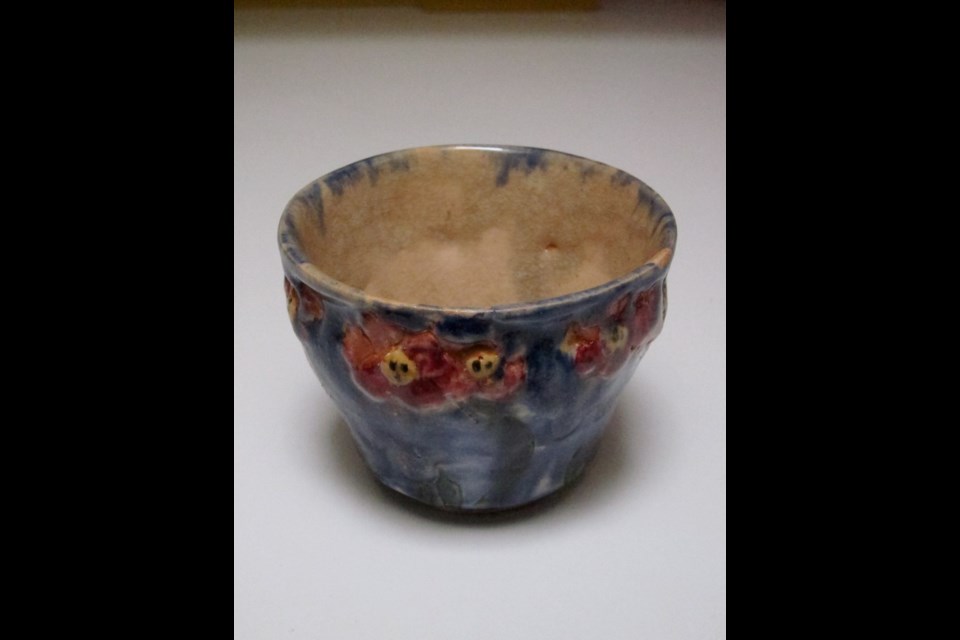 Allan Collier is passionate about our local history, as expressed in design. Just now, he’s on a quest for the roots of B.C. pottery.
Allan Collier is passionate about our local history, as expressed in design. Just now, he’s on a quest for the roots of B.C. pottery.
Collier first came to my attention as a member of the Woodworkers’ Guild in the 1980s. Slowly, his collecting activities, centring on chairs, came into view.
His chance discovery of a crucial cache of 1960s site photographs illuminated the history of Victoria’s modernist architecture. His collection of Canadian modern furniture has been shown at the Vancouver and Victoria art galleries, and at the University of Victoria. Currently, he’s developing an interest in pottery made in Victoria and Vancouver in the 1920s and 1930s.
Collier lives in a neat little bungalow on a side street with his wife, artist Mary-Lynn Ogilvie. At their dining-room table, he had arranged some of this early Victoria pottery. Low-fired and inelegant, some of it aimed at the tourist market, this has been ignored. It’s from the days before Jan and Helga Grove, before Ngan and Dexter and Hopper. It came before the Vancouver potters who went to St. Ives and worked with Bernard Leach. Collier is taking me way back.
He was inspired by a privately printed book by John Bosher, Imperial Vancouver Island.
“B.C. was not populated by people from eastern Canada,” Collier said. “The British military advised its men to settle in the North Island of New Zealand … or Victoria. They came to Shawnigan, Duncan, Comox.”
Bosher had two uncles who taught at the Vic High summer school for teachers during the 1920s, run by John Kyle. One uncle taught woodworking and the other taught metalwork. His aunts were well-known weavers.
Clearly, another Vancouver School of Art, founded in 1925, wasn’t going to happen in Victoria, so Kyle developed a summer school for the Department of Education, to teach teachers.
“And it was not just pottery,” Collier went on, “but the whole kind of arts and crafts things that John Kyle tried to promote.”
Charles H. Scott was on the staff, and Ira Dilworth was there. Emily Carr took an English course.
In the summer school of 1923, the pottery was in the hands of Mary Young, who had studied at the famed Alfred University in New York state, and then went to Banff. The Peter Whyte Museum there has her papers, Collier explained.
“She worked for the Department of Mines in Ottawa, where Harlan Smith was trying to promote Indian designs on manufactured goods. Mary Young was the person who made the pottery according to his designs. When she got to Victoria, she did experiments with local clays.”
Collier continued to intone long-forgotten names — Marion Macrae, Addie Greenwood, Frances Gatewood and Catherine Lothian.
“Margaret Kitto and Lilian Sweeney had the Deco Art Studio, and Margaret Grute had her pottery studio next door in same building. Carmichael, the famous silversmith, was just down the way,” Collier continued.
“Grute came over from England as a widow. She’d been to Goldsmith’s College in London. While in Victoria, she was a teacher and a potter, at the summer school in the mid-1920s and through the night school in the 1930s. She had her own studio in various places. I want to know more about her.”
He turned over a heavily potted plate, some glaze flaking off the rim. “I don’t like this stuff particularly,” Collier admitted, putting down the “clunker.” But his search has the fascination of archeology.
“A group of women took over the Kingston Street Elementary School and had a pottery club there from the 1920s to the late 1930s, when Ina Uhthoff took over. That might have been the Cottage Pottery.”
He suspects that the work he finds in thrift shops with “Indian” names, such as Kumtuk, comes from there.
For Collier, art history is where you find it.
“If it is ceramic and was made in Victoria, for $3, I’ll take it — and figure it out later.”
He’s just searching for the roots of modernism. “Did this start in 1949?” he asked. “That doesn’t sound right. What were other people doing before then?”
Of the few sources available for his research, he acknowledges as a very good book A Woman’s Place by K.A. Finlay (Maltwood Museum, Victoria 2004). And he also references Christina Johnson-Dean’s book on Ina Uhthoff (Mother Tongue Press, Salt Spring Island, 2012).
Collier brought out a red-glazed vase marked on the base with a large “M.” This might be by Margaret Grute.
“How am I going to know?” Collier muses. All he has to go on is an old photo of Grute in Canadian Geographic Magazine, teaching someone at a potter’s wheel. And the pottery? “I’m not going to make a claim. Help me figure it out.”
He continues to cruise the swap meets and the Internet, and brings back metalwork, weaving, textile design, hooked rugs and, of course, woodwork.
“I’m in the role of a temporary caretaker of this material,” Collier says. “Until that ultimate end” — which might be a book or an exhibition. But those rewards are a long time coming.
“Maybe a century from now,” the collector says ruefully. “But you’re a key payer in that whole process. People may die, someone else may have a better sense of it, but in the long run you’ll win. You have to do what you can do, and now is the time you have to do it.” He gestures toward his garage full of furniture. “There’s nowhere to put it, but you can’t just let these things go.”
To contact Allan Collier, email [email protected]
